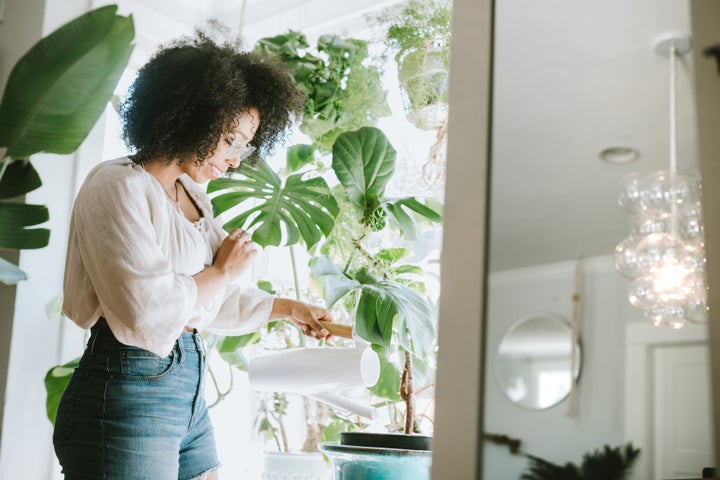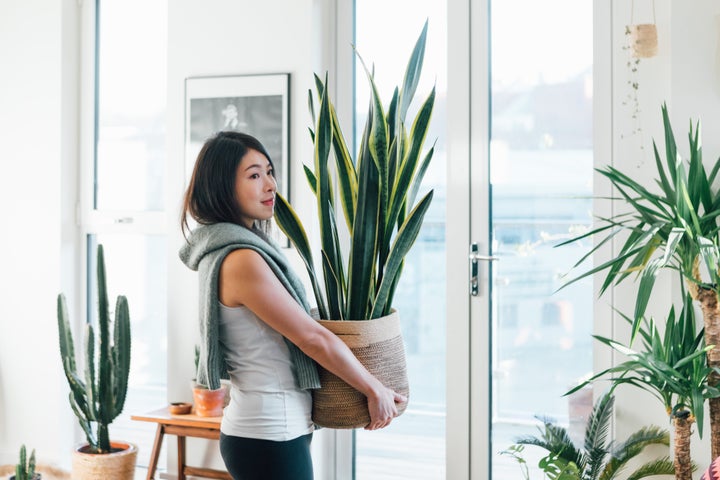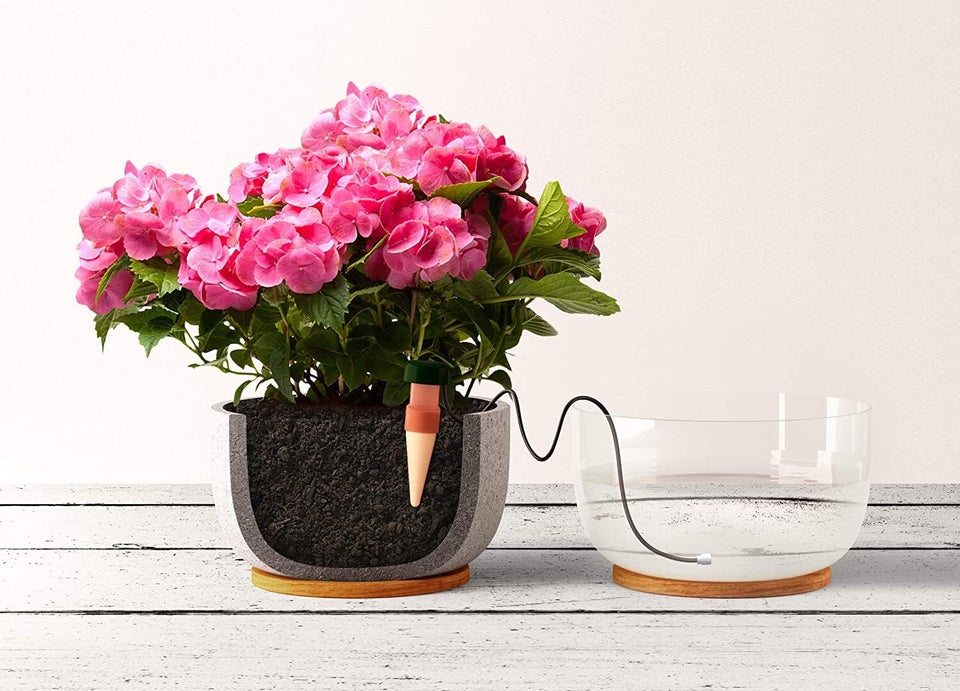
If you follow interior design influencers or otherwise keep up with trends in home decor, you’ve likely noticed the mania around houseplants. Indeed, over the past few years, millennials in particular have developed a love affair with all things green.
But as newcomers to the indoor plant world quickly learn, keeping your indoor flora alive can be challenging. The leaves may turn brown, wilt away, develop spots or otherwise fail to thrive. Still, there’s no need to despair!
“Plant parents of all skill levels have trouble with houseplants at one time or another, so don’t worry or be afraid to try, try again!” Liam Heeks, manager of Tula Plants & Design, told HuffPost.
To help new and aspiring plant parents, we asked experts to share the biggest mistakes they see people make with their houseplants. Read on for 19 approaches to avoid (and their advice for getting it right).
Choosing Plants For The Wrong Reasons
“I’d say the most common mistake that people make is purchasing plants based on how they look, or how trendy they are, instead of getting plants that can thrive in the quality of light they have in their homes.” ― Hilton Carter, plant and interior stylist and author of “Wild Creations,” “Wild Interiors” and “Wild At Home”
Getting Too Many At Once
“I’ve seen new plant parents get overly excited and go out and purchase too many varieties of plants at once. They end up losing a lot of those plants because it gets overwhelming trying to figure out which plant needs what type of care. My suggestion is to start with one or two new plants, learn about those and help them thrive, and then continue to add one new plant at a time.” ― Rachel Mayo, photographer and creator behind Grow in the Light
Keeping Plants Near Heat Or Air Sources
“You want to keep your plant’s environment as stable as possible. Most houseplants, just like us, are most comfortable between 65-80 degrees Fahrenheit. Extreme cold or hot fluctuations in temperatures can stress them out. Do your best to avoid placing plants near temperature hazards like vents, radiators, and exterior doors or open windows, which might create hot or cold drafts of air.” ― Erin Marino, editorial lead at The Sill
Overwatering
“Overwatering is one of the easiest ways to kill a houseplant. You may be tempted to water your plants on a strict schedule, but the best bet is to only water when needed. Always check the soil before watering. If it’s still moist, wait to water. Remember, it’s easier to add water than to remove it. I wait until I see signs of thirst like dropping or wrinkled leaves before watering.” ― Marino
“Plants that are overwatered may lead to yellowing of leaves, fungus/fungus gnats or root rot. A good tip for making sure you don’t overwater is using a moisture meter like the Sustee moisture meter and watering your plant once your meter goes from blue to white. You can also check by sticking your finger into the top few inches of soil, and also lifting up the pot to feel the weight. For plants like calathea who like to be kept consistently moist, water when you feel like the soil is a wrung out sponge!” ― Heeks
Forgetting To Fertilize
“Another mistake I’ve noticed is forgetting to fertilize plants. Many people think they can thrive off of water, alone. Plants need nourishment, just like humans do.” ― Mayo
Ignoring Seasonal Changes
“Keep in mind seasonal changes. For example, most houseplants need less water in the winter when they’re semi-dormant and receiving less sun.” ― Marino
Not Using Enough Water
“A lot of people are so scared to overwater their plants that they end up not using enough water to saturate the root system, resulting in a droopy, sad plant. If your pot has a drainage hole ― which it should ― don’t be afraid to really soak the soil on watering days.” ― Gabby Santiago, resident “plant doctor” with Rooted
“Underwatering may leave your leaves brown and crunchy, or your root systems may dry up and die back. Make sure to feel your soil before watering and know what conditions your plants thrive in. Watering schedules will change throughout the seasons, especially for cacti and succulents, so it’s best to do a little bit of research on your plant’s native habitat and growing conditions recommended for in the home.” ― Heeks

Choosing The Wrong Soil
“Many people don’t research the proper soil that their plants require. Some plants prefer soil that drains easily, some do not, etc.” ― Mayo
Putting It In An Unhealthy Spot
“A common mistake plant parents make is wanting to put a plant somewhere it may look nice but is not healthy for the plant. You might have a spot that you think would be great for a plant, but haven’t considered the conditions the plant needs to grow. Will the plant have enough light? Is the temperature of the space what the plant needs? Plants cannot thrive in all settings, so I like to determine what a plant needs before giving it a home.” ― Marcus Bridgewater aka Garden Marcus
Repotting Too Late Or Too Soon
“Repotting does not always mean moving your plant into a bigger planter ― sometimes it simply means changing your plant’s potting mix to provide it with new nutrients from fresh mix. However, if your plant has overgrown its current planter, you can choose a new pot that’s only slightly larger in size. Upsizing should be a gradual process throughout the years. You do not want your plant swimming in potting mix, which can lend itself to overwatering (to saturate all that extra soil that the roots don’t even reach), and potentially root rot.” ― Marino
“You want to make sure to be repotting when you notice the following: If you see roots growing out of the bottom of the pot, the plant is root bound, new growth seems stunted, or it is the growing season and you are not seeing growth. You would want to hold off on repotting when the growth is coming out beautiful and wild! If your plant is growing well but needs managing, I recommend pruning versus repotting. We recommend sizing up your pot 1 to 2 inches bigger than the pot the plant is currently in, but if you are not going to upsize, a soil refresh can be very beneficial!” ― Heeks
Providing Too Much Or Too Little Light
“A common mistake that plant parents make is giving the plant too much or too little light. Make sure that the conditions you are keeping your plants in match (or to your best abilities) the growing conditions required for the species. You can always supplement light with grow lights if you love cacti like me and have a north-facing window!” ― Heeks
“Know what your space has to offer in terms of light before condemning a plant to certain death. If you live in a low-light apartment and bring home a plant that requires bright, direct light to thrive, chances are, it’s going to die on you.” ― Santiago
Trying To Water On A Strict Schedule
“Never water on a schedule. However, check your plant on a schedule. If you’ve had a week of cloudy days, your plant won’t be photosynthesizing as much so it may not need water on the ‘scheduled’ day. Always check for moisture using your finger for smaller containers and a wooden dowel for larger containers. Push the dowel all the way to the bottom of the container and after letting it set for a minute or so, check the stick when you pull it out. If it is wet on the bottom of the stick, don’t water. If it’s dry, it is probably time to give your plant a drink. What’s going on at the top of a container, may not be what is happening in the bottom.” ― Lisa Eldred-Steinkopf aka The Houseplant Guru
“The most natural way to ask about watering is ‘how often do I water this plant?’ but the answer (e.g., once a week) is typically interpreted to mean that frequency is predetermined by plant type. But water usage varies based on many factors such as light, temperature, humidity, air flow, and soil type ― and these will differ for every person. A better approach is to regularly observe your plant’s soil moisture level to determine when to water. All plants will be ready for watering at one of these three soil moisture levels: When the soil is completely dry (cacti, succulents), when the soil is midway, partially dry (most tropical foliage plants), and when the soil is just slightly dry (sometimes referred to as ‘keep evenly moist’ ― many thin-leaved plants, most notably the maidenhair fern). You will eventually get the rhythm of when your plant reaches the appropriate level of dryness.” ― Darryl Cheng, author of “The New Plant Parent” and creator of House Plant Journal

Not Having A Drainage Hole
“One mistake I think new plant parents make is not having a container with a drainage hole. Using shards or pebbles for ‘drainage’ material does not work and is a hinderance to drainage. Drilling a hole is easy to do with a masonry or diamond-tipped drill bit. It is too hard to determine whether your plant has enough water to entirely moisten the root ball or too much water which is drowning the plant when it is in a pot without drainage.” ― Eldred-Steinkopf
Failing To Rotate
“After finding a suitable place for a plant, new plant parents may not realize they need to rotate their plant in its place, especially if it needs a lot of sun and only one side of it is facing sunlight.” ― Bridgewater
Forgetting About Bugs And Fungus
“A common mistake I frequently come across is that people often forget about protecting indoor plants from bugs and fungus! Just because a plant isn’t outside doesn’t mean it is safe from these ailments that can decrease plant longevity, growth, and overall look. As an easy fix, I recommend adding a product like Garden Safe brand fungicide to your plant parenting routine, spraying every week to two weeks to control houseplant bugs and prevent fungal infection.” ― Gladys Mbofung-Curtis, a plant scientist with Spectrum Home & Garden
Misinterpreting ‘Indirect’ Light
“Most people who hear ‘bright indirect light’ fixate on the word ‘indirect’ and believe that the best place for this kind of plant is anywhere that avoids direct sun. But in doing so, they usually end up putting the plant too far from the window, where the indirect light is much too weak, leading to poor growth and general dissatisfaction. Instead of just saying ‘bright indirect light,’ I try to be more specific about where to put the plant: First, put it as close to your largest window as possible ― where it will have the widest possible view of the sky. Second, if the duration of direct sun exposure will exceed two or three hours, then the ideal thing to do would be to block it with a white sheer curtain. This is the reason why people who have exceptionally large windows and/or skylights have nicer plants in the long run. They only need to keep up with watering. If your windows are small or highly obstructed, most plants will grow slowly and maybe poorly no matter how well you’re following watering instructions.” ― Cheng
Only Watering One Area Each Time
“Always water until the water runs out of the drainage hole and water all the way around the plant, not in just the same area each time. We want to ensure the entire root ball is moistened. If you only water on one side each time, especially with large plants, the roots on the other side may not be getting any water at all and then it is a mystery why half the plant may be dying. This pertains to cacti and other succulents, as well as ferns and other moisture loving plants. The time between waterings is the key. You may not water the cactus or succulent for a few weeks but the fern may need water the next week.” ― Eldred-Steinkopf
Over-caring For Plants
“It might sound silly, but less is more when it comes to caring for most houseplants. Plants are hardier than we think! They can tolerate a bit of neglect. Specifically, during the long winter months when most indoor plants are dormant, you’ll want to water them less and set your expectations for your plants to lose a few leaves ― a natural, seasonal shedding process that happens when plants don’t get enough sunlight to support their current leaves.” ― Marino
“Try not to obsess over every little thing, because an overbearing plant parent often becomes a plant killer. Trust us ― most of your plants are perfectly fine without you. Tending to them once a week is usually enough to keep them happy.” ― Santiago
Being Too Hard On Yourself
“If you kill a plant, it isn’t the end of the world. That is how you learn. Don’t be too hard on yourself. I’ve led many plants to their death. The key is paying attention to your plants and meeting their needs. No one is born with a green thumb, but with experience and some research, you can develop one.” ― Eldred-Steinkopf
Quotes have been edited and condensed for clarity.
